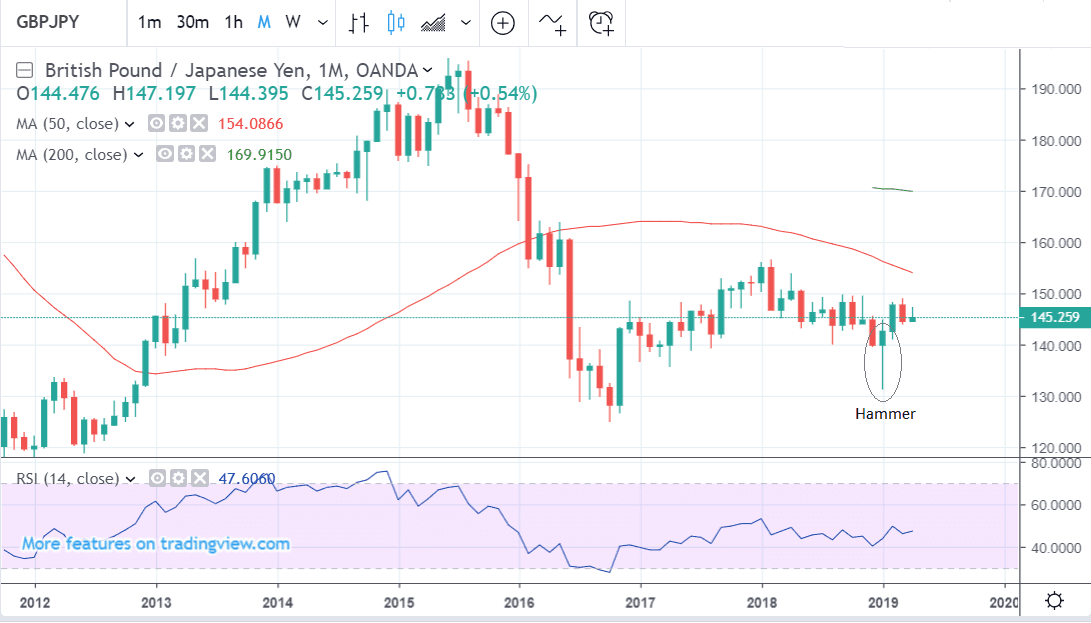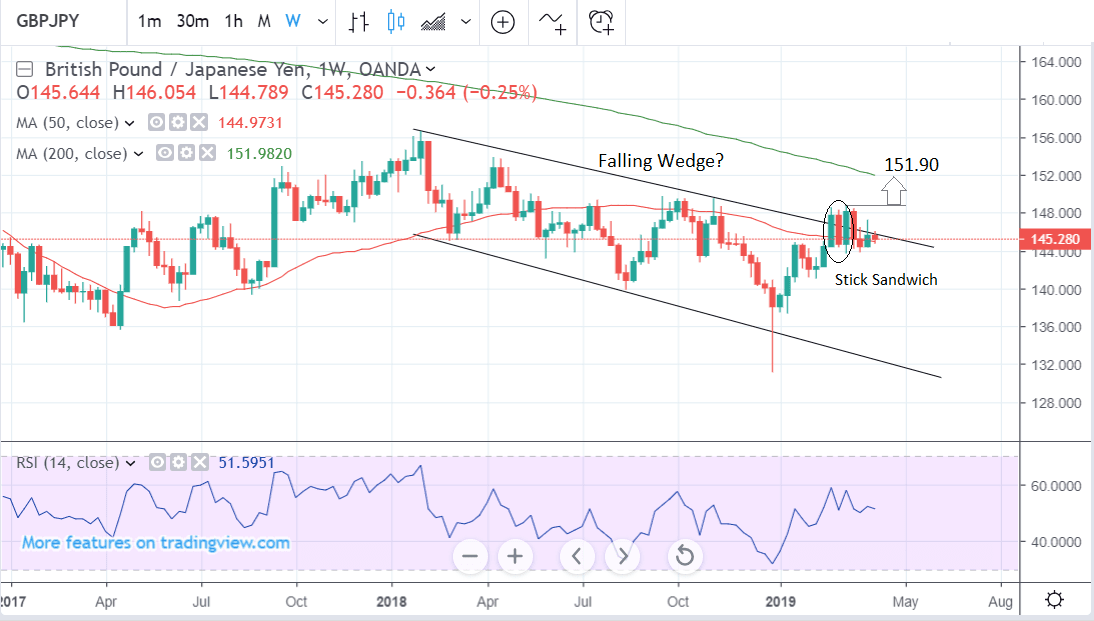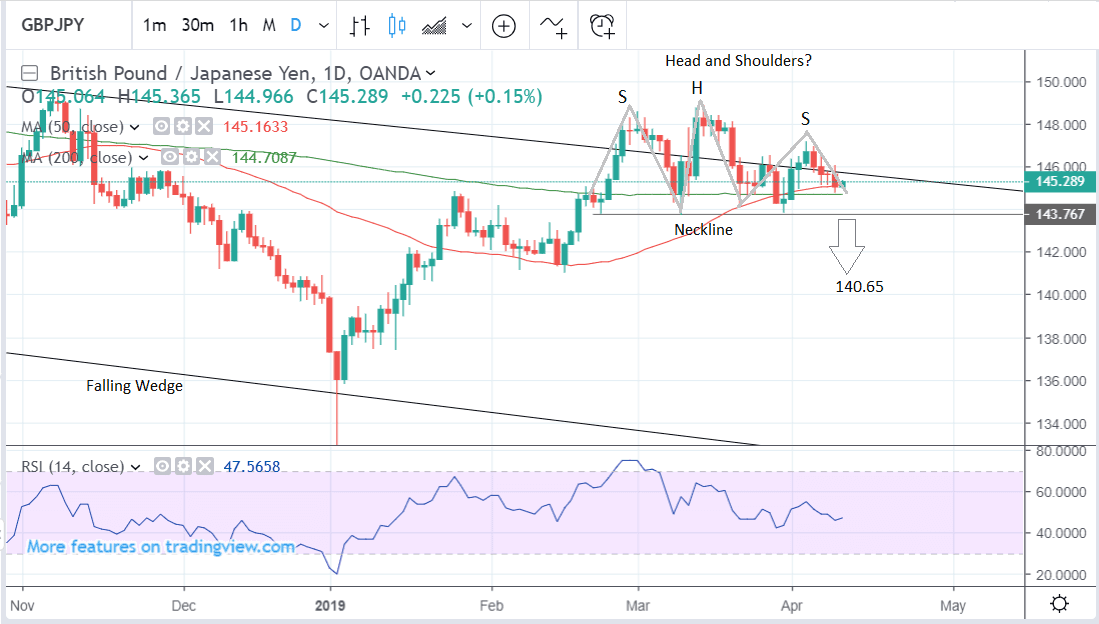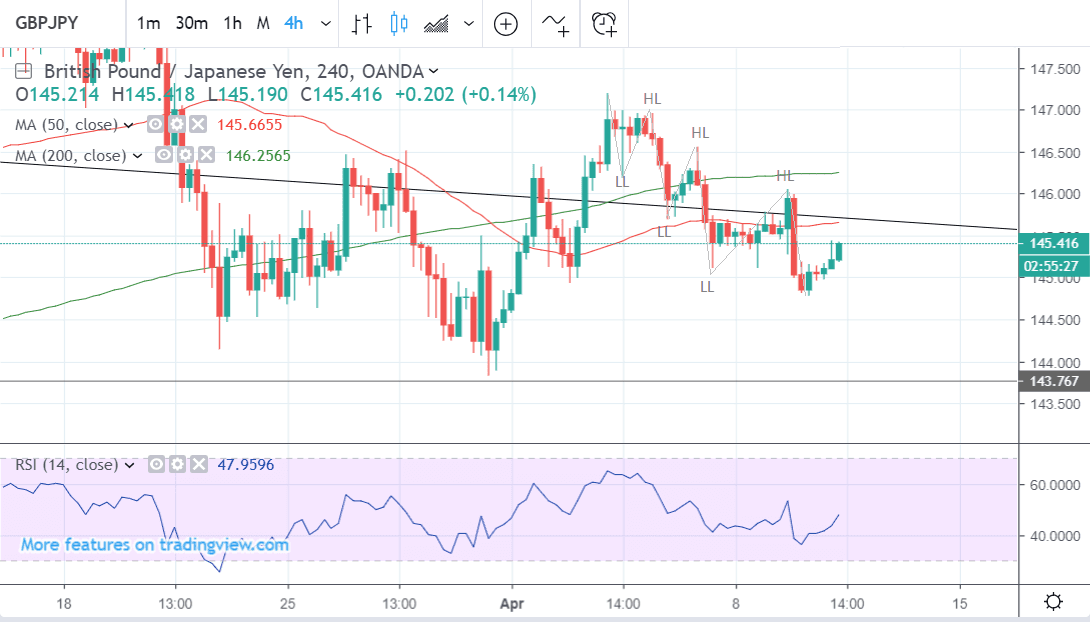The Pound-Yen Forecast Conundrum: Longer-Term Bullish, Short-Term Charts Bearish

Image © Adobe Stock
- GBP/JPY charts giving mixed signals
-EU-U.S. trade war could soon matter for JPY
- BoJ policy seen as supportive of JPY
The Pound-to-Yen exchange rate (GBP/JPY) is currently trading at 145.25 after having lost 0.25% in the first half of the new week in line with a soft tone to broader trade in the Sterling complex.
Determining where the exchange rate will go next ultimately depends on what timeframe is being viewed: the longer-term charts appear more bullish; the short-term ones more bearish.
The monthly chart - which gives a determination of the longer-term outlook - shows how the market bottomed in 2016, rose and then corrected back after peaking in early 2018. The most recent decline since then appears to be nothing more than a correction which will eventually stall, lead to the market basing and then a recovery higher.
The formation of the very clear hammer candlestick at the January 2019 lows further indicates a bullish bias. A break below the hammer seems implausible, purely from the look and feel of the chart, if nothing else.
It is also possible to interpret the decline during 2018 as a falling wedge pattern which is a bullish pattern as it is normally expected to eventually breakout higher.
Despite rising up to the top of the wedge and making several attempts to breakout higher, however, starting in February 2019, the pair has been unable to properly break free.
Assuming it does eventually breakout higher, confirmation of which would come from a move above the 148.88 highs, the next target would be expected to be at 151.90 near the 200-week MA.
GBP/JPY has formed a ‘stick sandwich’ Japanese candlestick pattern on the weekly chart which is a bearish signifier, and this led to some minor losses and brought the exchange rate back inside the wedge. This balances out the bullish view to some extent.
The daily chart looks substantially more bearish after having formed a head and shoulders topping pattern. A break below the neckline of the pattern at 145.75 would probably open the way to a more concerted fall to a downside target for the pattern at 140.65.
The declining momentum is further evidence supporting a possible breakdown.
The 50 and 200-day MAs are supporting the exchange rate at the current level and are likely to prove difficult to break below. There is a chance they may hold and provide a bedrock of support from which the exchange rate can mount a recovery, however, this has yet to be seen, and a clear break below the neckline would confirm a continuation lower.
The beginning of a step decline on the 4hr chart is further evidence of the possibility of a new downtrend evolving. The formation of a set of two or more lower lows and lower highs is one sign that a new downtrend may be beginning, and this appears to be the case on GBP/JPY.
Our overall stance, therefore, is neutral until a certain threshold is surpassed higher or lower to confirm the onset of a more definite
Time to move your money? Get 3-5% more currency than your bank would offer by using the services of foreign exchange specialists at RationalFX. A specialist broker can deliver you an exchange rate closer to the real market rate, thereby saving you substantial quantities of currency. Find out more here.
* Advertisement
Potential U.S.-EU Trade War Could Become an Important Driver of JPY Direction
We expect the main fundamental driver of the Yen to remain global investor risk appetite over coming days, with the Yen's safe-haven status likely to ensure it rises when global markets are being sold, and falls when investors are snapping up stocks.
In particular we are watching for any potential escalation in the brewing tariff tensions between the U.S. and Europe.
A raft of highly-anticipated U.S. tariffs on European goods were announced on Tuesday, that will target EU-manufactured aircraft, motorcycles, cheese and wine totalling a value of US$11bn.
The announced tariffs are a fraction of the more than $250bn worth of Chinese goods currently under U.S. tariffs.
We therefore saw little reaction by the markets, and by extension Japan's Yen, to the news.
But, this is certainly something that is now on our radar.
"The direction is worrisome," says Mark Matthews with Julius Baer, "what started as a dispute between the world’s two largest commercial aircraft manufacturers is now spreading to other sectors, and the European Union (EU) said it is ready to respond in kind."
"Even if we are only talking planes and agriculture for now, tariffs on cars are likely to become an issue again soon. And that would really hurt the European economy," says Ulrich Leuchtmann, an analyst with Commerzbank in Frankfurt.
Looking to potential domestic drivers of the Yen, a further positive could prove to be the Japanese central bank, the BOJ, which appears to have reduced the extent of its stimulus programme.
The programme involves the purchasing of assets from financial institutions: scaling back any form of stimulus by a central bank tends to support that bank's currency.
“Slower balance sheet expansion from the BoJ has resulted in further weakness in broad money growth, normally a medium term driver of a stronger JPY,” say analysts at Citibank in a recent note.
This may have something to do with a, sort of, accommodative policy fatigue. For years the BOJ has kept interest rates ultra low and used stimulus to try to raise inflation but to no avail.
Both finance minister Taro Aso and prime minister Shinzo Abe have suggested recently, that the BOJ’s 2.0% inflation target is unrealistic and should be lowered.
Although governor Kuroda is sticking to his guns, it's possible a reduction in the target could be on the cards which might also be Yen supportive as it would make a rate rise a more realistic prospect.
Time to move your money? Get 3-5% more currency than your bank would offer by using the services of foreign exchange specialists at RationalFX. A specialist broker can deliver you an exchange rate closer to the real market rate, thereby saving you substantial quantities of currency. Find out more here.
* Advertisement




